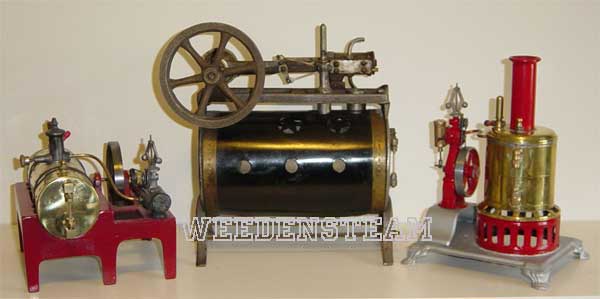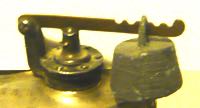

|
Operating Your Weeden Steam Engine. If you are not familiar with the operation of toy steam engines read this entire page before attempting to run an engine. Visual InspectionIt is important to do a visual inspection of any used engine before attempting to run it, some things to look for. Compare the model to the photos on this site, are there any obvious missing parts that will affect the operation of the engine, things like the governor, smoke stack and top of whistle are often missing but are purely cosmetic in most cases. Are the gaskets intact, as the material ages it may crumble and need replacing. Check for loose steam lines, gentle wiggle the pipes to make sure they are secure at the joints. Is the sight glass tube intack? Is the safety valve functional, does the lever type have the weight attached, is the newer style plunger type free to move? Is the connecting rod connected to the crank, often the pin is misssing on the molded lead cranks. On the vertical models, particularily on steel boiler types, turn the unit upside down and looking inside the firebox check the bottom of the boiler for any pin holes. Be suspicious of any repairs that have resulted in large blobs of solder, this generally means the solder was not heated enough to flow into the joint and is only sitting on the surface resulting in a weak joint. Starting up with an Alcohol Burner Style UnitLubricate all moving parts. Fill burner 1/2 full with alcohol. Fill boiler 1/2 full with hot water. Light burner, insert in firebox and wait for water to boil. When you think you have steam try the whistle, if it works give flywheel a flip. Engine should run for about 15 minutes. Keep an eye on the water level, do not run boiler dry. Starting up with an Electric Element Style UnitLubricate all moving parts. Fill boiler 1/2 full with hot water. Plug unit in When you think you have steam try the whistle, if it works give flywheel a flip. Engine should run for about 15 minutes. Keep an eye on the water level, do not run boiler dry. Shut DownAlways drain the remaining water from the boiler, a large syringe with a flexible hose works well for this. Wipe the unit down to remove any water and oil residue. It is tempting to turn the unit upside down to drain the boiler, however if there is any loose scale in the boiler it can enter the steam line and plug it. Alcohol BurnersThe burners consist of a tank, and one or more wicks, the wicks are generally made of cotton, today a common source are the smaller styles for patio lamps, in a pinch string form a cotton floor mop will work. They should not be too tight in the tube or too loose, it may take a bit of experimenting to acheive a nice flame. Some tanks have filler plugs, others are filled by removing the wick, the tanks must be vented, some through a hole in the plug, others through a small tubular handle. Fill the burner about 1/2 full with Wood Alcohol which is also known as Methanol, Methyl Hydrate or Methylated Spirits, it is most commonly available in the paint section of a hardware store were it is sold as a solvent for shellac flakes. I like to use a syringe to fill the burner, alcohol vapors can communicate flame, so fire doesn’t have to touch the liquid, it can ignite the vapor that comes from evaporating alcohol. Always be sure the flame has been extinguished when refilling the burner, outside in daylight it is often difficult to see the burning flame. Electric ElementWeedens were manufactured in the USA so they all run on 110 volt power. Most have detachable cords which fit on a two prongs that are 11/16" apart, they were manufactured before grounded outlets became the norm so it is a good idea to add a third ground wire, instructions are here. Caution must used to be sure the boiler does not run out of water when using electrically heated engines. Replacement cords are available. Steam BoilerThe boiler is a sealed tank that holds the water which is heated to produce the steam to run the engine, it will have a safety valve, whistle and sight glass attached to it. A steam line will feed the engine, some steam lines will have a throttle valve to control the speed of the engine. The boiler is filled by removing the safety valve. Filling the boiler with hot water will allow the engine to run sooner and longer on a burner tank of fuel. Boilers are constructed of either tin or brass, unfortunately many of the tin boilers now have pin holes rusted in them because they were not emptied after using them. Safety ValveThere are two common safety valves, the older models used a style with a weighted arm, the newer models used a spring loaded plunger. Always make sure the safety valve is operational, it is there to release any excess pressure that builds up in the boiler. This may happen if the engine is stalled so no steam is being used by the engine, or if the burner has a hotter flame than necessary.
WhistleWeeden whistles are famous for being rather pathetic, they generally produce a hiss rather than a high pitched whistle sound, occasionally one lucks out and gets a good one. Sight Glass
EngineThere are two basic types of engines, oscillatting or with a rod style steam valve, there are both single and double acting models. Most are reversible, but not all of them. GovernorThe governors on these engines are are not functional, but it is fascinating to watch them spinning around. Replacements are available. LubricationAny parts that come in contact with steam should be lubricated with steam oil, other parts such as axles and linkages can be lubricated with a light oil such as 3in1. As the saying goes, "any oil is better than none", so if you don't have steam oil on hand then the occasional use of a general purpose oil will be okay, but do get some for future use. WaterThere is much debate about the proper water to use, I use tap water where I live as we are blessed with very good water, a good indicator is our tea kettle, it is over 10 years old and has no scale built up. If you have hard water then use distilled water, some add 5% tap water to add some minerals to it so the water does not leach the brass the boiler is made from. Weeden used pretty good brass in their boilers so dezinc is not as much of a problem as with some other brands. RepairsRepairs to steam lines can be made with ordinary soft solder and a small torch, use caution as many components on the units are made of lead that melts at a very low temperature. It was common to punch the boiler holes in the factory then thread the lip formed which resulted in very few actual threads formed. Over time these threads easily become stripped so have to be repaired by soldering in new bushings. The bushing require a 5/16" diameter hole, this is best made with a tapered hand reamer, a drill bit tends to catch and rip the thin brass. Once the holes are enlarged and the metal is shinny clean I wrap some 1/16" diameter acid core solder around the bottom of the bushing, drop it in the hole and heat the bushing until it drops down to the surface if the boiler, makes a nice clean fix. Back to IndexWeeden
Steam Store |


